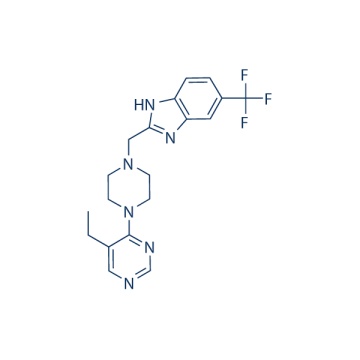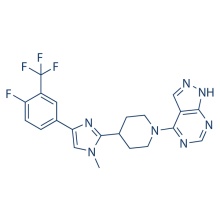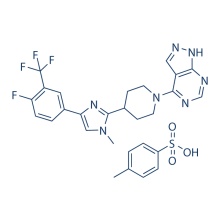.cp_wz tabla {borde superior: 1px sólido #ccc; borde izquierdo: 1px sólido #ccc; } .cp_wz table td {borde derecho: 1px sólido #ccc; borde inferior: 1px sólido #ccc; padding: 5px 0px 0px 5px;} .cp_wz table th {border-right: 1px solid #ccc; border-bottom: 1px solid #ccc; padding: 5px 0px 0px 5px;} \ n Peso molecular: 390.41 PF-4708671 es un inhibidor permeable a las células de la quinasa ribosomal S6 p70 (isoforma S6K1) con Ki / IC50 de 20 nM / 160 nM, una selectividad 400 veces mayor para S6K1 que S6K2, y 4 y> 20 veces la selectividad para S6K1 que MSK1 y RSK1 / 2, respectivamente. Primer inhibidor específico de S6K1 del que se informa. \ N PF-4708671 es un análogo de piperazinilpirimidina y el primer inhibidor específico de S6K1. PF-4708671 no inhibe significativamente la actividad de la isoforma S6K2 estrechamente relacionada o varias otras quinasas AGC (Akt1, Akt2, PKA, PKCα, PKCϵ, PRK2, ROCK2, RSK1, RSK2 o SGK1). PF-4708671 previene la fosforilación de la proteína S6 mediada por S6K1 en respuesta a IGF-1 (factor de crecimiento similar a la insulina 1), mientras que no tiene efecto sobre la fosforilación inducida por PMA de sustratos de la RSK altamente relacionada (p90 ribosomal S6 quinasa) y quinasas MSK (quinasas activadas por mitógenos y por estrés). También se ha encontrado que PF-4708671 induce la fosforilación del bucle en T y el motivo hidrófobo de S6K1, un efecto que depende de mTORC1 (complejo 1 de mTOR). PF-4708671 no afecta la actividad de mTORC1. \ n Protocolo (solo como referencia) Ensayo de quinasa: [1]
|
Protein kinase activity assays
|
For selectivity IC50 assays, purified active GST–S6K1, GST–S6K2, His–MSK1 (residues 2–802), His–RSK1 (residues 1–735) and His–RSK2 (residues 2–740) (0.5 units/mL) are assayed for 30 min at 30 °C in a 50 μL assay mixture in buffer A containing either 30 μM Crosstide (GRPRTSSFAEG, for S6K1, S6K2 and MSK1) or 30 μM Long S6 (KEAKEKRQEQIAKRRRLSSLRASTSKSGGSQK, for RSK1 and RSK2), 10 mM magnesium acetate and 100 μM [γ- 32P]ATP. Reactions are terminated and the incorporation of [γ-32P]phosphate into the peptide substrate is determined by applying the reaction mixture on to P81 phosphocellulose paper and scintillation counting after washing the papers in phosphoric acid. One unit of activity is defined as that which catalysed the incorporation of 1 nmol of [32P]phosphate into the substrate. To determine the Ki for PF-4708671, full-length recombinant S6K1 is added to a final concentration of 5 nM to Omnia assay buffer containing various concentrations of compound. The reaction is run for 60 min at 30 °C in a 50 μL assay volume. The fluorescence of the peptide is monitored at an excitation wavelength of 360 nm and an emission wavelength of 485 nm. The rate of the reaction at each compound concentration is normalized to the DMSO control rate, and this normalized rate against concentration is fitted to the Morrison tight-binding equation for a competitive inhibitor to provide the true Ki. In order to assay S6K activity in HEK-293 cell lysates, cells are lysed in Tris lysis buffer. Lysate (0.5 mg) is incubated with 5 μg of S6K antibody conjugated to Protein G–Sepharose for 1 h at 4 °C on a vibrating platform. Immunoprecipitates are washed twice with lysis buffer and twice with buffer A, and kinase activity is assayed exactly as described above using the Crosstide peptide.
|
Conversión de diferentes modelos de animales basados en BSA (valor basado en datos del Borrador de Directrices de la FDA)
|
Species
|
Baboon
|
Dog
|
Monkey
|
Rabbit
|
Guinea pig
|
Rat
|
Hamster
|
Mouse
|
|
Weight (kg)
|
12
|
10
|
3
|
1.8
|
0.4
|
0.15
|
0.08
|
0.02
|
|
Body Surface Area (m2)
|
0.6
|
0.5
|
0.24
|
0.15
|
0.05
|
0.025
|
0.02
|
0.007
|
|
Km factor
|
20
|
20
|
12
|
12
|
8
|
6
|
5
|
3
|
|
Animal A (mg/kg) = Animal B (mg/kg) multiplied by
|
Animal B Km
|
|
Animal A Km
|
Por ejemplo, para modificar la dosis de resveratrol utilizada para un ratón (22,4 mg / kg) a una dosis basada en el BSA para una rata, multiplique 22,4 mg / kg por el factor Km para un ratón y luego divida por el factor Km para una rata. Este cálculo da como resultado una dosis equivalente para ratas de resveratrol de 11,2 mg / kg.
|
Rat dose (mg/kg) = mouse dose (22.4 mg/kg) ×
|
mouse Km(3)
|
= 11.2 mg/kg
|
|
rat Km(6)
|
\ n Descarga de información química PF-4708671 SDF
|
Molecular Weight (MW)
|
390.41
|
|
Formula
|
C19H21F3N6
|
|
CAS No.
|
1255517-76-0
|
|
Storage
|
3 years -20℃Powder
|
|
6 months-80℃in solvent (DMSO, water, etc.)
|
|
Synonyms
|
|
|
Solubility (25°C) *
|
In vitro
|
DMSO
|
30 mg/mL
(76.84 mM)
|
|
Water
|
<1 mg/mL
(
|
|
Ethanol
|
8 mg/mL
(20.49 mM)
|
|
In vivo
|
30% PEG400/0.5% Tween80/5% propylene glycol
|
30 mg/mL
|
* <1 mg/ml means slightly soluble or insoluble.
* Please note that Selleck tests the solubility of all compounds in-house, and the actual solubility may differ slightly from published values. This is normal and is due to slight batch-to-batch variations.
|
|
Chemical Name
|
1H-Benzimidazole, 2-[[4-(5-ethyl-4-pyrimidinyl)-1-piperazinyl]methyl]-6-(trifluoromethyl)-
|
Calculadora de molaridad Calculadora de dilución Calculadora de peso molecular
Grupos de Producto : PI3K / Akt / mTOR > Inhibidor de quinasa S6








